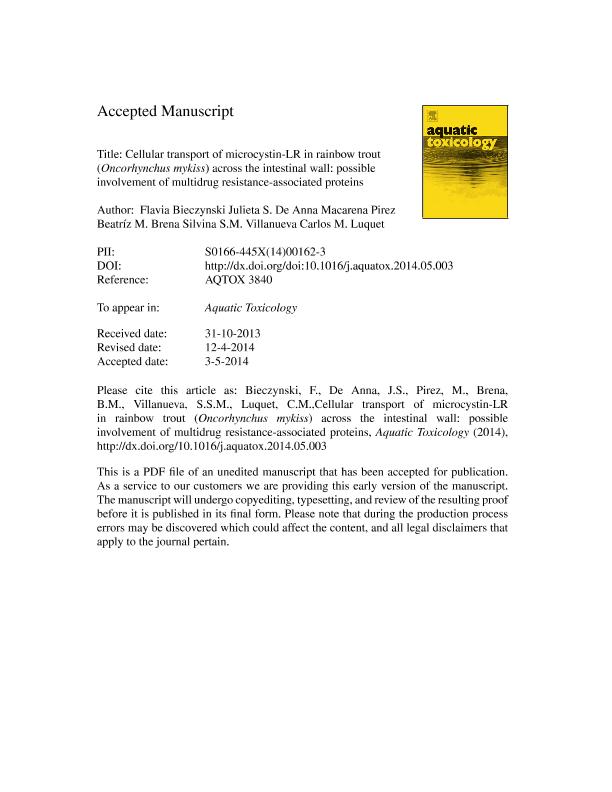Mostrar el registro sencillo del ítem
dc.contributor.author
Bieczynski, Flavia

dc.contributor.author
de Anna, Julieta Soledad

dc.contributor.author
Pirez, Macarena
dc.contributor.author
Brena, Beatriz M.
dc.contributor.author
Villanueva, Silvina Stella Maris

dc.contributor.author
Luquet, Carlos Marcelo

dc.date.available
2017-01-30T20:34:25Z
dc.date.issued
2014-09
dc.identifier.citation
Bieczynski, Flavia; de Anna, Julieta Soledad; Pirez, Macarena; Brena, Beatriz M.; Villanueva, Silvina Stella Maris; et al.; Cellular transport of microcystin-LR in rainbow trout (Oncorhynchus mykiss) across the intestinal wall: possible involvement of multidrug resistance-associated proteins; Elsevier Science; Aquatic Toxicology; 154; 9-2014; 97–106
dc.identifier.issn
0166-445X
dc.identifier.uri
http://hdl.handle.net/11336/12212
dc.description.abstract
We studied Abcc mediated-transport in middle and posterior intestine of the rainbow trout, Oncorhynchus mykiss. Luminal and serosal transport were evaluated in everted and non-everted intestinal sacs, respectively, incubated with 1-chloro-2,4-dinitrobenzene (CDNB; 200 μM). CDNB enters the cells and is conjugated with glutathione via glutathione S-transferase (GST) to form 2,4-dinitrophenyl-S-glutathione (DNP-SG), a known Abcc substrate. DNP-SG concentration in the bath was recorded every 10 min, in order to calculate the mass-specific transport rate. For evaluating the possible involvement of Abcc proteins in microcystin-LR (MCLR) transport, 1.135 μM MCLR was added to the bath or inside the sacs, in everted or non-everted preparations, respectively. Both luminal and serosal DNP-SG efflux were significantly inhibited by MCLR. A concentration–response curve obtained using strips from middle intestine yielded an IC50 value of 1.33 μM MCLR. The Abcc inhibitor, MK571 produced concentration-dependent inhibition of DNP-SG similar to that produced by MCLR. Since competition of MCLR and CDNB as GST substrates could bias the DNP-SG transport results, we evaluated the effects of MCLR on calcein efflux, which does not depend on GST activity. We applied the non-fluorescent, cell-permeant compound calcein-AM (0.25 μM) to middle intestinal strips and recorded the efflux of its hydrolysis product, the fluorescent Abcc substrate calcein. 2.27 μM MCLR and 3 μM MK571 inhibited calcein efflux (17.39 and 20.2%, respectively). Finally, MCLR interaction with Abcc transporters was evaluated by measuring its toxic intracellular effects. Middle intestinal segments were incubated in saline solution with 1.135 μM MCLR (MC1), 2.27 μM MCLR (MC2), 3 μM MK571 (MK) or 1.135 μM MCLR + 3 μM MK571 (MC1/MK). After 1 h, GSH concentration, protein phosphatase 1 and 2A (PP1, PP2A) and GST activities were measured in each segment. MC1did not produce significant effect while MC1/MK and MC2 significantly inhibited PP1and PP2A in similar proportions (34–49%). MK alone significantly increased PP2A activity (40%) with no effect in any other variable. GST activity and GSH concentration were not affected by any treatment. Concentration–response curves for MCLR (1.135 to 13.62 μM) alone or plus 3 or 6 μM MK571 were obtained using PP1 activity as response variable. The IC50 values were 1.0, 0.52, and 0.37 μM, respectively. Our results suggest that O. mykiss enterocytes are capable of eliminating MCLR by GST-mediated conjugation and luminal excretion through an Abcc-like apical transporter. This mechanism would prevent toxic effects and reduce the toxin uptake into the blood, which is likely mediated by basolateral Abccs.
dc.format
application/pdf
dc.language.iso
eng
dc.publisher
Elsevier Science

dc.rights
info:eu-repo/semantics/openAccess
dc.rights.uri
https://creativecommons.org/licenses/by-nc-nd/2.5/ar/
dc.subject
Cyanotoxin
dc.subject
Trout Intestine
dc.subject
Intestinal Sacs
dc.subject
Detoxification
dc.subject
Abcc Transporter
dc.subject
Oncorhynchus Mykiss
dc.subject.classification
Otras Ciencias Biológicas

dc.subject.classification
Ciencias Biológicas

dc.subject.classification
CIENCIAS NATURALES Y EXACTAS

dc.title
Cellular transport of microcystin-LR in rainbow trout (Oncorhynchus mykiss) across the intestinal wall: possible involvement of multidrug resistance-associated proteins
dc.type
info:eu-repo/semantics/article
dc.type
info:ar-repo/semantics/artículo
dc.type
info:eu-repo/semantics/publishedVersion
dc.date.updated
2016-12-12T14:23:36Z
dc.journal.volume
154
dc.journal.pagination
97–106
dc.journal.pais
Países Bajos

dc.journal.ciudad
Amsterdam
dc.description.fil
Fil: Bieczynski, Flavia. Consejo Nacional de Investigaciones Científicas y Técnicas. Centro Científico Tecnológico Patagonia Norte. Instituto de Investigación En Biodiversidad y Medioambiente; Argentina. Universidad Nacional del Comahue; Argentina
dc.description.fil
Fil: de Anna, Julieta Soledad. Consejo Nacional de Investigaciones Científicas y Técnicas. Centro Científico Tecnológico Patagonia Norte. Instituto de Investigación En Biodiversidad y Medioambiente; Argentina. Universidad Nacional del Comahue; Argentina
dc.description.fil
Fil: Pirez, Macarena. Universidad de la Republica. Facultad de Quimica; Uruguay
dc.description.fil
Fil: Brena, Beatriz M.. Universidad de la Republica. Facultad de Quimica; Uruguay
dc.description.fil
Fil: Villanueva, Silvina Stella Maris. Consejo Nacional de Investigaciones Científicas y Técnicas. Centro Científico Tecnológico Rosario. Instituto de Fisiología Experimental (i); Argentina
dc.description.fil
Fil: Luquet, Carlos Marcelo. Consejo Nacional de Investigaciones Científicas y Técnicas. Centro Científico Tecnológico Patagonia Norte. Instituto de Investigación En Biodiversidad y Medioambiente; Argentina. Universidad Nacional del Comahue; Argentina
dc.journal.title
Aquatic Toxicology

dc.relation.alternativeid
info:eu-repo/semantics/altIdentifier/doi/http://dx.doi.org/10.1016/j.aquatox.2014.05.003
dc.relation.alternativeid
info:eu-repo/semantics/altIdentifier/url/http://www.sciencedirect.com/science/article/pii/S0166445X14001623
Archivos asociados
